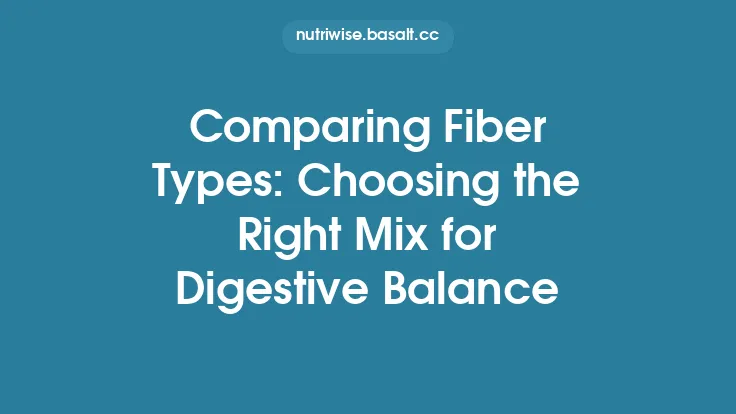Choosing a probiotic can feel overwhelming, especially with the sheer number of brands, formulations, and marketing claims that line the shelves. While the science of gut microbiota continues to evolve, certain practical considerations remain consistently relevant for anyone seeking to reap the most benefit from a probiotic supplement. This guide walks you through the key factors to evaluate—beyond the basics of “what is a probiotic”—so you can make a decision that aligns with your health objectives, lifestyle, and personal circumstances.
Identify Your Specific Health Goals
Probiotic supplements are not one‑size‑fits‑all. The first step is to clarify why you are interested in adding a probiotic to your regimen. Common motivations include:
| Goal | Typical Desired Outcomes | Practical Implications |
|---|---|---|
| Digestive comfort (e.g., bloating, occasional constipation) | Improved regularity, reduced gas | Look for strains with documented effects on bowel habits |
| Immune support | Fewer upper‑respiratory infections, balanced inflammatory response | Choose products that have been studied in immune‑related contexts |
| Vaginal health | Reduced yeast infections, balanced vaginal flora | Seek formulations that include lactobacilli known to colonize the vaginal tract |
| Metabolic health (e.g., weight management, blood sugar) | Modest improvements in insulin sensitivity, appetite regulation | Prioritize products backed by clinical trials in metabolic endpoints |
| Mental well‑being (the gut‑brain axis) | Lower perceived stress, improved mood | Identify strains with evidence for neuroactive metabolite production |
By anchoring your selection to a concrete health target, you can filter out generic products and focus on those that have been specifically evaluated for the outcome you care about.
Assess Strain Relevance Without Over‑Emphasizing Differences
While the broader literature acknowledges that different bacterial strains can exert distinct physiological effects, the practical takeaway for most consumers is to look for evidence‑based strain selections that align with your health goal. Rather than getting lost in the taxonomy of *Lactobacillus rhamnosus versus Lactobacillus casei*, ask:
- Has this strain been studied in human trials for my intended purpose?
- Is the strain isolated from a human source (as opposed to dairy or environmental origins)?
- **Does the manufacturer provide the exact strain designation (e.g., *Lactobacillus rhamnosus* GG)?**
A product that lists a well‑researched strain and cites peer‑reviewed studies offers a more reliable foundation than one that merely advertises “multiple strains” without supporting data.
Consider Formulation and Delivery Technology
The way a probiotic is packaged can dramatically influence how many viable organisms actually reach your intestines. Key formulation aspects to evaluate include:
- Enteric Coating – A protective polymer layer that resists stomach acid, dissolving only in the higher‑pH environment of the small intestine. This technology can boost survival rates for acid‑sensitive strains.
- Microencapsulation – Tiny beads or liposomal structures that encase bacteria, shielding them from heat, moisture, and gastric acidity.
- Spore‑Forming Species – Certain *Bacillus* strains naturally form spores, which are inherently resistant to harsh conditions and may not require additional protective measures.
- Matrix Composition – Probiotics delivered in a dairy base (e.g., yogurt powder) can benefit from natural buffering, whereas dry powders rely solely on the protective technologies mentioned above.
When reviewing a product, look for explicit mention of these delivery mechanisms. If the label is silent, assume the formulation may be more vulnerable to degradation before reaching the gut.
Evaluate Viability and Shelf‑Life
A probiotic’s potency is only meaningful if the organisms remain alive until consumption. While the “CFU count” itself is a separate topic, you should still verify:
- Manufacturing Date vs. Expiration Date – Viability declines over time; a product with a long shelf‑life relative to its production date is preferable.
- Storage Requirements – Some formulations are stable at room temperature, while others demand refrigeration. Choose a storage condition that fits your lifestyle to avoid inadvertent loss of potency.
- Stability Claims – Look for statements such as “stable for 24 months at 25 °C” backed by stability testing data.
A product that transparently reports its stability profile and provides realistic storage guidance is more likely to deliver the advertised number of live organisms.
Look for Clinical Validation and Research Support
The probiotic market is saturated with products that make broad health promises without scientific backing. To separate evidence‑based options from hype:
- Check for Human Clinical Trials – Prefer products that reference randomized, double‑blind, placebo‑controlled studies involving the exact formulation (strain(s) and dosage) you intend to use.
- Review Publication Quality – Peer‑reviewed articles in reputable journals carry more weight than conference abstracts or unpublished data.
- Assess Sample Size and Population – Larger, well‑characterized study cohorts (e.g., adults with IBS) provide more reliable evidence than small pilot studies.
Manufacturers that openly link their product to specific research papers demonstrate a commitment to transparency and scientific rigor.
Verify Quality Assurance and Third‑Party Testing
Because probiotic supplements are regulated as foods rather than drugs in most jurisdictions, the onus of quality falls on the manufacturer. Key quality checkpoints include:
- Good Manufacturing Practices (GMP) Certification – Indicates adherence to standardized production protocols.
- Third‑Party Verification – Independent labs (e.g., NSF International, USP, ConsumerLab) may test for label accuracy, microbial contamination, and presence of unwanted substances.
- Batch‑Specific Testing – Some brands provide a QR code or batch number that links to a certificate of analysis (CoA) for that specific lot.
A product that can substantiate its claims through external testing reduces the risk of contamination, mislabeling, or sub‑therapeutic potency.
Match the Product to Your Personal Health Profile
Individual factors can influence how well a probiotic works for you:
- Age – Infants, children, adults, and seniors have differing gut microbiota compositions and immune statuses. Some formulations are tailored for specific life stages.
- Pregnancy or Lactation – Certain strains have been studied for safety and efficacy in pregnant or nursing individuals; choose those with explicit endorsements.
- Medication Interactions – If you are on antibiotics, immunosuppressants, or antifungals, discuss timing and strain selection with a healthcare professional.
- Underlying Conditions – People with compromised immune systems (e.g., organ transplant recipients) may need to avoid live bacterial supplements altogether.
A thorough self‑assessment—or a brief consultation with a clinician—helps ensure the probiotic you select is appropriate for your physiological context.
Review Ingredient Transparency and Potential Allergens
Beyond the probiotic organisms themselves, the excipients and carrier ingredients can affect tolerability:
- Allergen Statements – Dairy, soy, gluten, and shellfish are common allergens in supplement matrices. Look for clear labeling if you have sensitivities.
- Prebiotic Additives – Some products blend prebiotic fibers (e.g., inulin) to support bacterial growth. While generally safe, they can cause gas or bloating in sensitive individuals.
- Artificial Additives – Colorants, sweeteners, and preservatives may be unnecessary and could trigger reactions in certain users.
A clean ingredient list that discloses all components, including the source of the probiotic (e.g., “derived from human fecal isolates” vs. “fermented dairy”), empowers you to make an informed choice.
Factor in Practical Aspects: Cost, Convenience, and Sustainability
Even the most scientifically robust probiotic loses value if it does not fit into your daily routine or budget:
- Cost per Effective Dose – Calculate the price per recommended daily serving rather than per bottle; some high‑CFU products may be more economical in the long run.
- Dosage Frequency – Products requiring multiple daily doses may suffer from lower adherence compared to once‑daily formats.
- Packaging Sustainability – Recyclable containers, minimal plastic use, and responsibly sourced ingredients reflect a brand’s commitment to environmental stewardship—a consideration for many consumers today.
Balancing efficacy with practicality ensures you can maintain consistent use, which is essential for achieving lasting benefits.
Make an Informed Purchase Decision and Monitor Outcomes
After narrowing down options based on the criteria above, the final step is to commit to a trial period and track your response:
- Baseline Assessment – Document symptoms, dietary habits, and any relevant health metrics before starting the probiotic.
- Structured Trial – Use the product consistently for at least 4–8 weeks, the typical timeframe needed for gut colonization and observable effects.
- Outcome Logging – Keep a simple journal noting changes in digestion, energy levels, mood, or any adverse reactions.
- Re‑evaluation – If desired outcomes are not achieved, consider switching to a product with a different strain composition or delivery system, or consult a healthcare professional for personalized guidance.
Probiotic supplementation is a dynamic process; ongoing observation allows you to fine‑tune your approach and maximize the health dividends.
By systematically applying these considerations—clarifying health goals, scrutinizing strain relevance, evaluating formulation technology, confirming viability, demanding clinical evidence, ensuring quality assurance, aligning with personal health status, checking ingredient transparency, weighing practical factors, and monitoring results—you can navigate the crowded probiotic marketplace with confidence. The right probiotic, selected thoughtfully, can become a powerful ally in supporting a resilient gut ecosystem and overall well‑being.





